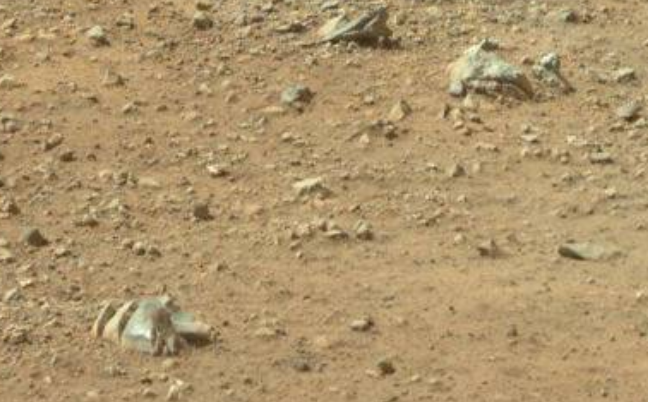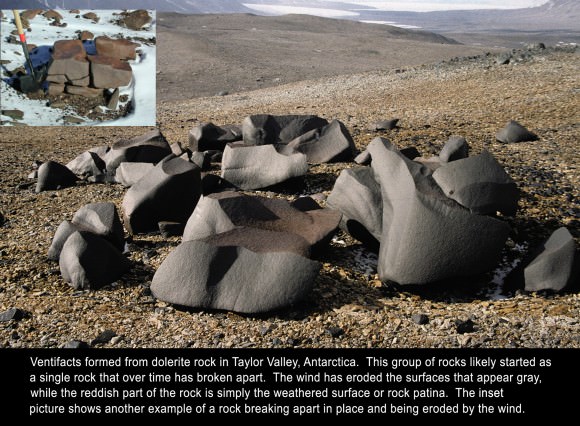It looks like you're using an Ad Blocker.
Please white-list or disable AboveTopSecret.com in your ad-blocking tool.
Thank you.
Some features of ATS will be disabled while you continue to use an ad-blocker.
share:
a reply to: Helenamatias
I really don't thinks that is metal. I think the sun is reflecting off of some smooth rock. You can see other small rocks with the same sheen as the ones circled. I think the "tube" may look that way due to shadows.
Just my opinion.
AB
I really don't thinks that is metal. I think the sun is reflecting off of some smooth rock. You can see other small rocks with the same sheen as the ones circled. I think the "tube" may look that way due to shadows.
Just my opinion.
AB
was hoping they had a picture of rey looting an old imperial star destroyer!
seriously, never believed the story of the probe we sent to mars that crashed. why? because WE built the probe. and WE use feet and inches in our measurements. their excuse? "we failed to change from meters to yards". since when did NASA go to the metric system?
seriously, never believed the story of the probe we sent to mars that crashed. why? because WE built the probe. and WE use feet and inches in our measurements. their excuse? "we failed to change from meters to yards". since when did NASA go to the metric system?
originally posted by: Davg80
a reply to: TefarimCanin
but are all the bodies in our solar system moving away from the sun and if they are and have always been does that mean we came from the sun. like a piece of the suns projectile spew.
I don't think that the distance between planet and sun changes from its set course. Although a perfect circular orbit might have become elliptical somehow I don't think the sun is pulling the planets closer.
Planets operate like satellites. In orbit they stay if not forced out by something.
a reply to: blackthorne
I've noticed American scientists and engineers using the metric system plenty of times.
I suppose millimetres are kind of vital when measurements need to be exact... as opposed to just saying "give it half an inch buddy, that should be close enough".
I've noticed American scientists and engineers using the metric system plenty of times.
I suppose millimetres are kind of vital when measurements need to be exact... as opposed to just saying "give it half an inch buddy, that should be close enough".
a reply to: Helenamatias
You realise how big the PLANET Mars is...don't you?
There is NO way a single small rover would stumble upon an old mission by chance, especially since NO other missions, failed or successful has ever been to this area on Mars, let alone to Gale Crater...the nearest previous mission to mars, was Spirit Rover's mission to Gusev Crater almost 1,500 miles away from where this image was taken...!
If you had a fleet of a hundred rovers, the chances of stumbling over a past mission by chance is astronomical (no pun intended)...it would be like a single person roaming around Antarctica, where only 12 people have ever been previously but all twelve separated by at least 1000 miles...and finding one of their rucksacks! It simply is NOT going to happen.
You realise how big the PLANET Mars is...don't you?
There is NO way a single small rover would stumble upon an old mission by chance, especially since NO other missions, failed or successful has ever been to this area on Mars, let alone to Gale Crater...the nearest previous mission to mars, was Spirit Rover's mission to Gusev Crater almost 1,500 miles away from where this image was taken...!
If you had a fleet of a hundred rovers, the chances of stumbling over a past mission by chance is astronomical (no pun intended)...it would be like a single person roaming around Antarctica, where only 12 people have ever been previously but all twelve separated by at least 1000 miles...and finding one of their rucksacks! It simply is NOT going to happen.
edit on 11 5 2016 by MysterX because: Deleted text
originally posted by: Mianeye
What are the odds for Curiosity to stumble upon this debris, or did NASA seek it out, knowing the position of the object.
Extremely high to zero.
Why would they have chosen Gale crater for a risky multi-billion dollar mission, when they already had Spirit rover over in Gusev crater showing them the exact lay of the land which would have made a risky landing by Curiosity there much less so..? Gusev is about the same size as Gale, is thought to have had an ancient lake following impact just like Gale...so why would NASA send a multi-billion dollar mission to an unknown crater with almost identical pedigree to Gusev given all they had learned from Spirit roving around in it...unless they knew something about Gale that they're not telling us.
edit on 11 5 2016 by MysterX because: typo
a reply to: TefarimCanin
mate i found this, it says we are constantly moving away, if mars was once in the goldilocks zone then it could have had life at one time, im gonna look more into this to see if its possible, cheers for your reply
mate i found this, it says we are constantly moving away, if mars was once in the goldilocks zone then it could have had life at one time, im gonna look more into this to see if its possible, cheers for your reply
a reply to: Helenamatias
I am retired from a three letter fedreal agency as a program manager in the field of catrography and feature analysis using stereo photogrammetry and specializing in imagery analysis and photo interpretation of natural and man made features. Projects also included stereo 3-D mapping of the Moon for NASA during all the 'Apollo Lunar Landing Missions', where we produced various maps and other data of the landing zones, alternate landing zones, and other assignments by NASA.
Obviously this is one of those very rare features on Mars that is definitely not a rock.
My first thought was that it was likely debris from an orbital platform or the the last stage during a payload landing. However I am tending to discount that based on the soil around the object. If you take a close look you do not see any signs of impact, skid mark, or the crater that would form around something coming out of orbit with impact. Also observing the edges of the object to the soil it appears that this object has been there for quite some length of time that allowed the surrounding soil to be built up around the feature naturally, and with some depth.
As to what it exactly is I cannot say, however it has the obvious appearance of a tank with an attached tube.
It is a mystery for these eyes, but I've seen stranger stuff in my specialized profession that turned out to have a logical answer. Maybe there is a answer that NASA or someone informed that can furnish, or not?
mars.jpl.nasa.gov...
I am retired from a three letter fedreal agency as a program manager in the field of catrography and feature analysis using stereo photogrammetry and specializing in imagery analysis and photo interpretation of natural and man made features. Projects also included stereo 3-D mapping of the Moon for NASA during all the 'Apollo Lunar Landing Missions', where we produced various maps and other data of the landing zones, alternate landing zones, and other assignments by NASA.
Obviously this is one of those very rare features on Mars that is definitely not a rock.
My first thought was that it was likely debris from an orbital platform or the the last stage during a payload landing. However I am tending to discount that based on the soil around the object. If you take a close look you do not see any signs of impact, skid mark, or the crater that would form around something coming out of orbit with impact. Also observing the edges of the object to the soil it appears that this object has been there for quite some length of time that allowed the surrounding soil to be built up around the feature naturally, and with some depth.
As to what it exactly is I cannot say, however it has the obvious appearance of a tank with an attached tube.
It is a mystery for these eyes, but I've seen stranger stuff in my specialized profession that turned out to have a logical answer. Maybe there is a answer that NASA or someone informed that can furnish, or not?
mars.jpl.nasa.gov...
edit on 11-5-2016 by lunarcartographer because: sp
originally posted by: Davg80
a reply to: TefarimCanin
mate i found this, it says we are constantly moving away, if mars was once in the goldilocks zone then it could have had life at one time, im gonna look more into this to see if its possible, cheers for your reply
I suppose the vaccum of space could cause that to happen. Maybe.
a reply to: lunarcartographer
The answer was on page 2
www.abovetopsecret.com...
The panorama was taken at the LANDING SITE in Aug 09 2012 no mystery just another youtuber trying to snare the gullible.
The picture was taken 3 days after landing and as Martian dust gets blown around it could easily be part of the landing system.
The answer was on page 2
www.abovetopsecret.com...
The panorama was taken at the LANDING SITE in Aug 09 2012 no mystery just another youtuber trying to snare the gullible.
The picture was taken 3 days after landing and as Martian dust gets blown around it could easily be part of the landing system.
originally posted by: MysterX
originally posted by: Mianeye
What are the odds for Curiosity to stumble upon this debris, or did NASA seek it out, knowing the position of the object.
Extremely high to zero.
Why would they have chosen Gale crater for a risky multi-billion dollar mission, when they already had Spirit rover over in Gusev crater showing them the exact lay of the land which would have made a risky landing by Curiosity there much less so..? Gusev is about the same size as Gale, is thought to have had an ancient lake following impact just like Gale...
Because of Mt. Sharp, now officially known as Aeolis Mons.
Gale Crater was the landing site, but Mt. Sharp was the main target for the science that they wanted to do, although Gale Crater was a good scientific target in its own right.
Mt. Sharp was laid down layer by layer over span of a few billion years. At least some of those layers were believed to be laid down by sediment in water (water from the lake that believed to once fill Gale Crater) and from aerobic means (sedimentary layers laid down by windstorms).
So the layers of Mt. Sharp represent a geologic history of the past few billion years on Mars. Also (and importantly), those layers are exposed in canyon walls and buttes that are accessible by the rover; therefore the rover can actually get up close enough to touch and see the different layers of geologic history that Mt. Sharp presents to it, and to us.
edit on 5/11/2016 by Box of Rain because: (no reason given)
a reply to: MysterX
Or...it was because it showed the best evidence of once having flowing water.
Oh and what did they discover in 2013?
www.nytimes.com...
Or...it was because it showed the best evidence of once having flowing water.
Oh and what did they discover in 2013?
About 3.5 billion years ago — around the time life is thought to have first arisen on Earth — Mars had a large freshwater lake that might well have been hospitable to life, scientists reported Monday.
www.nytimes.com...
originally posted by: wmd_2008
...The picture was taken 3 days after landing and as Martian dust gets blown around it could easily be part of the landing system.
I dunno. I think this better resolution image of the object makes it look more like a rock than a piece of equipment
(the object is at the bottom of the image):
mars.jpl.nasa.gov...
a reply to: wmd_2008
"The picture was taken 3 days after landing and as Martian dust gets blown around it could easily be part of the landing system."
I don't discount that possibilty. I would like to see a match up of the object to some pictures of the actual landing hardware . However you make a valid point about a strong sandstorm in that 3 day period could account for the setting, that is a possiblity.
My main point was that it was not a rock; but a man made feature.
"The picture was taken 3 days after landing and as Martian dust gets blown around it could easily be part of the landing system."
I don't discount that possibilty. I would like to see a match up of the object to some pictures of the actual landing hardware . However you make a valid point about a strong sandstorm in that 3 day period could account for the setting, that is a possiblity.
My main point was that it was not a rock; but a man made feature.
edit on 11-5-2016 by lunarcartographer because: add
originally posted by: AboveBoard
a reply to: Helenamatias
I really don't thinks that is metal. I think the sun is reflecting off of some smooth rock. You can see other small rocks with the same sheen as the ones circled. I think the "tube" may look that way due to shadows.
That's what it looks like to me, a shiny rock, at least part of it is shiny.
originally posted by: Box of Rain
I dunno. I think this better resolution image of the object makes it look more like a rock than a piece of equipment
(the object is at the bottom of the image):
mars.jpl.nasa.gov...
Mars has some pretty big sandstorms so if the right kind of rock is blasted with sand from sandstorms I see no reason it can't get shiny like that.
Here's an example of shiny rocks from Antarctica, so yes rocks can get shiny surfaces:
www.universetoday.com...
The shiny "hood ornament" in that article looks more like a man-made artifact than the subject of this thread, but it's not man-made either.
Compare those Antarctica rocks to the rock in the OP, sen in the lower left below, and also the rock in the upper right which appears to also have a shiny part of a similar color:

edit on 2016511 by Arbitrageur because: clarification
a reply to: Box of Rain
Agree it looks more like a rock there but my point was that as the image was taken just after landing if it was metal it could easily be part of the landing system. It is most likely a sand blasted rock.
Agree it looks more like a rock there but my point was that as the image was taken just after landing if it was metal it could easily be part of the landing system. It is most likely a sand blasted rock.
new topics
-
New York Governor signs Climate Law that Fines Fossil Fuel Companies
US Political Madness: 5 hours ago -
Meta Llama local AI system is scary good
Science & Technology: 10 hours ago
top topics
-
This is why ALL illegals who live in the US must go
Social Issues and Civil Unrest: 12 hours ago, 18 flags -
New York Governor signs Climate Law that Fines Fossil Fuel Companies
US Political Madness: 5 hours ago, 12 flags -
Former ‘GMA Producer’ Sues NPR-Legacy Media Exposed
Propaganda Mill: 16 hours ago, 9 flags -
Happy Hanukkah…
General Chit Chat: 16 hours ago, 8 flags -
UK Borders are NOT Secure!
Social Issues and Civil Unrest: 14 hours ago, 6 flags -
Meta Llama local AI system is scary good
Science & Technology: 10 hours ago, 6 flags -
New Footage - Randy Rhoads 1979 LIVE Guitar Solo Footage at the Whisky - Pro Shot
Music: 16 hours ago, 5 flags
active topics
-
Elon Musk futurist?
Dreams & Predictions • 14 • : cherokeetroy -
UK Borders are NOT Secure!
Social Issues and Civil Unrest • 6 • : angelchemuel -
New York Governor signs Climate Law that Fines Fossil Fuel Companies
US Political Madness • 11 • : EyeoftheHurricane -
Trump says ownership of Greenland 'is an absolute necessity'
Other Current Events • 53 • : cherokeetroy -
Happy Hanukkah…
General Chit Chat • 23 • : JJproductions -
This is why ALL illegals who live in the US must go
Social Issues and Civil Unrest • 23 • : WeMustCare -
Statements of Intent from Incoming Trump Administration Members - 2025 to 2029.
2024 Elections • 57 • : WeMustCare -
Meta Llama local AI system is scary good
Science & Technology • 24 • : glend -
The Mystery Drones and Government Lies --- Master Thread
Political Conspiracies • 153 • : WeMustCare -
Putin Compares Himself to Jesus Promoting Traditional Values Against the Satanic West
Mainstream News • 77 • : Dalamax


